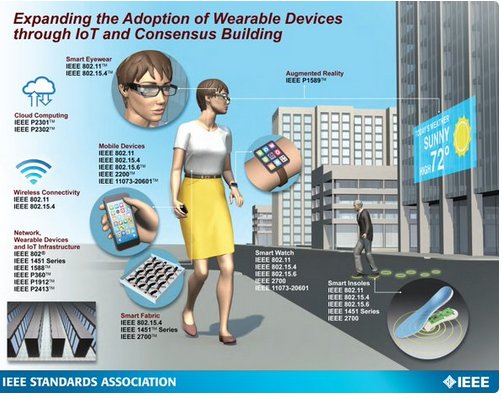IoT and wearable devices: How standardisation is helping to drive market adoption

(c)iStock.com/RyanKing999
It’s predicted that as part of the IoT, connected devices could grow to reach 50 billion by 2020 - and a lot of that growth will be attributed to wearable technology. The medical industry and healthcare providers have been at the forefront of utilising wearable technology to monitor trends, assess medications, and adjust therapies based on behavioural patterns and data collection from wearable devices.
Still, there are a lot of other potential applications emerging in the wearable devices space, but what’s clear is that standardisation is key to providing the needed functionality, interoperability and security to help continue to drive the market forward and ensure all these devices can work together seamlessly and to maximum benefit for all who employ them. The IEEE Standards Association (IEEE-SA) has been working in a number of areas to help build consensus on the adoption of wearable devices.

IEEE 802.15.4™ Standard for Low-Rate Wireless Personal Area Networks (LR-WPANs) supports fundamental lower network layers of a type of wireless personal area network (WPAN) that will provide low-cost, low-speed ubiquitous communication between devices.
Unlike IEEE 802.11, or Wi-Fi, which offers higher bandwidth requiring more power, IEEE 802.15.4 is focused on enabling very low cost communication of nearby devices with little to no underlying infrastructure, and is particularly suited for near data transfer to handheld wireless devices and RFID applications in the 868/915/2450 MHz frequency bands.
For broader wearable applications, such as health monitoring and consumer electronics, the IEEE 802.15.6™ Standard for Wireless Body Area Network (WBAN) provides an international standard for low power, short range, and extremely reliable wireless communication within the surrounding area of the human body, supporting a vast range of data rates for different applications.
Short-range, wireless communications in the vicinity of, or inside, a human body are specified in this standard. It uses existing industrial scientific medical (ISM) bands as well as frequency bands approved by national medical and/or regulatory authorities. Support for quality of service (QoS), extremely low power, and data rates up to 10 Mbps is required while simultaneously complying with strict non-interference guidelines where needed. What’s more, this standard considers effects on portable antennas due to the presence of a person (varying with male, female, skinny, heavy, etc.), radiation pattern shaping to minimise the specific absorption rate (SAR) into the body, and changes in characteristics as a result of the user motions.
Other work related to the medical immigration of devices and ensuring the interoperability of wearable technology has resulted in the IEEE 11073™ family of standards, which enables communication between medical, health care and wellness devices, and with external computer systems. They provide automatic and detailed electronic data capture of client-related and vital signs information, and of device operational data. The IEEE 11073 standards have been developed with a high level of international participation. They have been, and continue to be, adopted as International Organisation for Standardisation (ISO) standards through ISO TC215 Health Informatics and as European standards through the Committee for European Normalisation (CEN) TC251 Health Informatics, specifically as the CEN ISO/IEEE 11073 series. The end result is a single set of internationally harmonised standards that have been developed and adopted by ISO and CEN member countries.
Standardisation work to bridge wearable data transfer to the cloud via a wireless device comes under the auspices of IEEE P2301™—Guide for Cloud Portability and Interoperability Profiles (CPIP). Its purpose is to assist cloud computing vendors and users in developing, building, and using standards-based cloud computing products and services.
Cloud computing systems contain many disparate elements. For each element there are often multiple options, each with different externally visible interfaces, file formats, and operational conventions. This guide enumerates options, grouped in a logical fashion called "profiles," for such definitions of interfaces, formats, and conventions, from a variety of sources. In this way, cloud ecosystem participants will tend towards more portability, commonality, and interoperability to accelerate the cloud computing adoption rate. The guide advises cloud computing ecosystem participants of standards-based choices in areas such as application interfaces, portability interfaces, management interfaces, interoperability interfaces, file formats, and operation conventions.
A key concern related to wearable devices is security and privacy. IEEE-P1912™—Standard for Privacy and Security Architecture for Consumer Wireless Devices describes a common communication architecture for devices equipped with near field communication (NFC), home area network (HAN), wireless area network (WAN) wireless personal area network (WPAN) technologies or radio frequency identification technology (RFID) considering proximity. It specifies approaches for end user security through device discovery/recognition, simplification of user authentication, tracking items/people under user control/responsibility, and supports alerting, while supporting privacy through user controlled sharing of information independent of the underlying wireless networking technology used by the devices.
Another IEEE-SA project underway is IEEE P2413™ – Standard for an Architectural Framework for the Internet of Things (IoT). This overarching architectural framework includes standardisation efforts in all the various vertical markets, including medical, in order to integrate them into a larger framework of objects and architecture references, and to better align sensors and IoT devices in a dynamic interoperable system level architecture.
Clearly there is quite a lot of standardisation work being done to help foster success for all the various IoT stakeholders for wearable devices and technology. With the support of industry, and an open standards strategy that builds consensus for the adoption of wearable devices, IEEE continues to work to advance these emergent IoT technologies for the benefit of all of humankind.
Picture credit: IEEE
 Interested in hearing industry leaders discuss subjects like this and sharing their IoT use-cases? Attend the IoT Tech Expo World Series events with upcoming shows in Silicon Valley, London and Amsterdam to learn more.
Interested in hearing industry leaders discuss subjects like this and sharing their IoT use-cases? Attend the IoT Tech Expo World Series events with upcoming shows in Silicon Valley, London and Amsterdam to learn more.
The show is co-located with the AI & Big Data Expo, Cyber Security & Cloud Expo and Blockchain Expo so you can explore the entire ecosystem in one place.

Leave a comment
Alternatively
This will only be used to quickly provide signup information and will not allow us to post to your account or appear on your timeline.